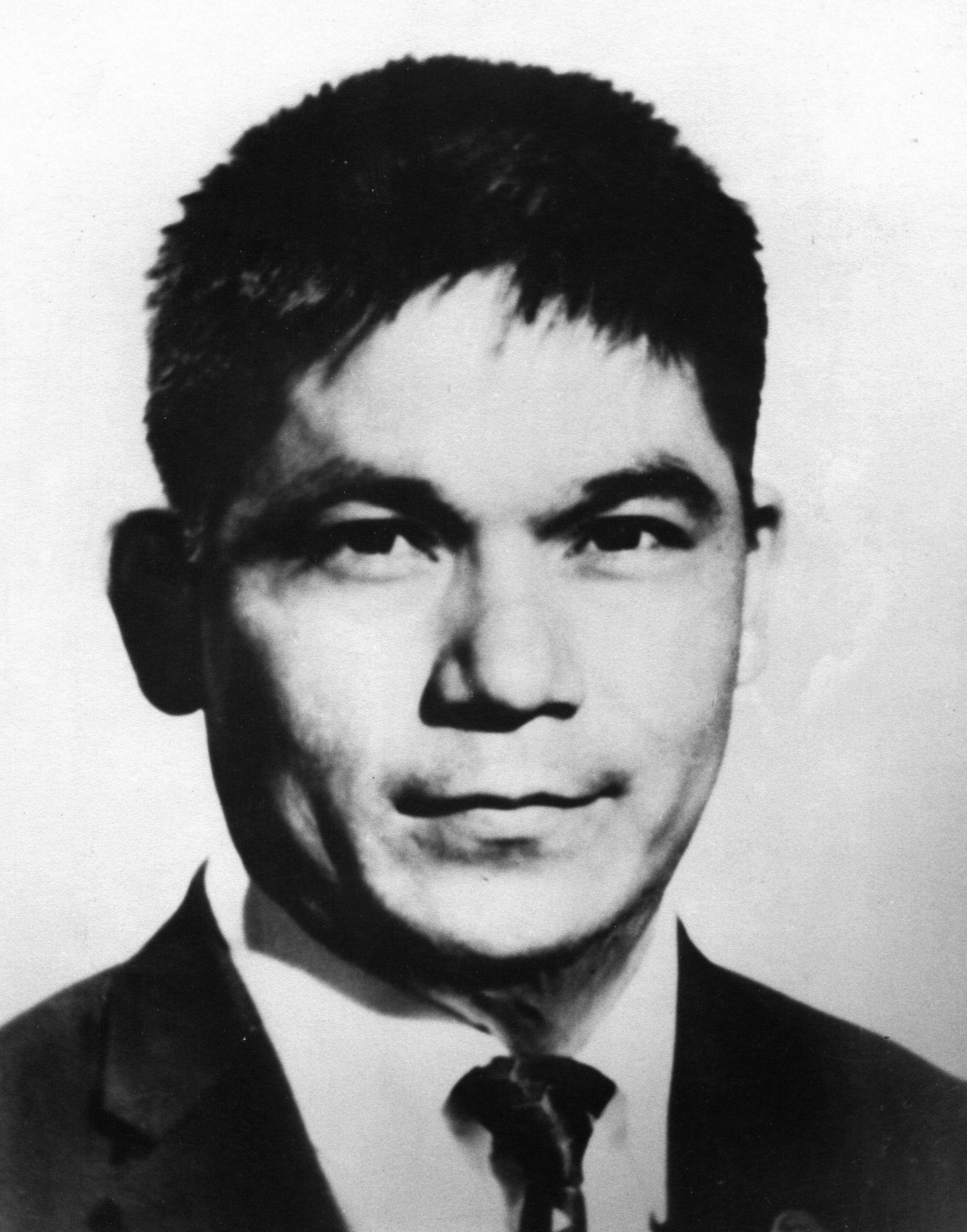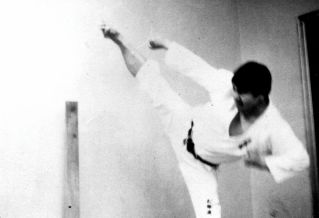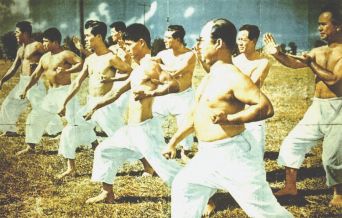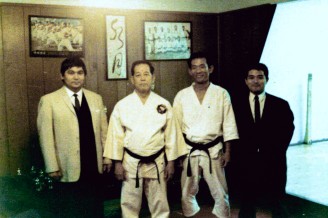Ansei Ueshiro inducted in 2024

Ansei Ueshiro (hereinafter, “Sensei Ueshiro”) arrived in the U.S. at age 29, when his flight from Okinawa touched down in New York on September 15, 1962. On hand to greet his arrival was Ohioan James K. Wax, who along with Frank Grant, sponsored Sensei Ueshiro’s entry into the United States. James Wax was the first American to be awarded a black belt rank by Master Shoshin Nagamine, who was the founder of his Matsubayashi-Ryu version of Shorin Ryu, and the Sensei of Sensei Ueshiro. A former U.S. Marine, who had been stationed on Okinawa, much of James Wax’s instructional training at Master Nagamine’s dojo had been supervised by Sensei Ueshiro. An abiding and lasting friendship evolved.
Sensei Ueshiro’s arrival was to have resounding and enduring re verberations, with such cementing the presence and eventual wide spread expansion of Matsubayashi- Ryu within the United States, and with his influencing and enhancing the lives of many with whom he was to come in contact, setting the high bar standard for all engaged in the pursuit of karate excellence.
Wasting no time, a core nucleus of early New York black belts, which included Ernest Ferrara, James Fitzgerald, Zenko Heshiki, Joseph Johnson and Joseph Fuschi were assembled to assist Sensei Ueshiro with the establishment of Matsubayashi-Ryu in New York. Training dojos were established on Jamaica Avenue, in Woodhaven, Queens, on Sullivan Street in Manhattan, and at 668 Fulton Avenue in Hempstead (designated as the U.S.A. headquarters location). During the next two years, intensive training and promotions ensured the presence and support of additional black belts, such as Joseph Avella, James Zermeno, Arthur Ng, Joseph King, Kenneth Ruiz and Gus Impagliazzo. New dojos were opened in Huntington Station, Patchogue, St. James, Riverhead and on West 72nd Street in Manhattan. Under Sensei Ueshiro’s personal leadership and tutelage, Matsubayashi-Ryu had taken strong root and prospered to become a permanent presence in New York.
In Ohio, Hanshi Frank Grant had been receiving karate instruction from James Wax. Sensei Ueshiro made a number of trips to Ohio to assist James Wax with the promotion of Matsubayashi- Ryu. It was then that Hanshi Grant began his training with Sensei Ueshiro and, in 1963, he was promoted to 1st Dan black belt. Two years later, he was promoted to 2nd Dan by Sensei Ueshiro. In 1965, Sensei Ueshiro resided for about six months with Hanshi Grant and his family and together they established a dojo on 5th Street in Dayton, which they named the “Ansei - Frank Karate Club.”
Early on, at the School of Okinawa headquarters dojo in Hempstead, NY, Sensei Ueshiro taught most of the evening classes. New York black belt Steve Corriss, who joined in 1963, recalled that the karate training under Sensei Ueshiro was strict and uncompromising. Each student, both novice and those more advanced, were expected to give full faith and serious effort to the training lessons. Kumite practice was included in all the classes. Hard physical contact was far more the general rule than the exception. No protective gear was available. The kumite sessions were most often conducted one-on-one. Though, Sensei Ueshiro would sometimes pair off two-on-one and three-on-one. At other times, kumite sparring would be restricted to hands only, or kicks only. And, sometimes, it would be “hands only vs kicks only.”
Push-up exercises were an integral part of each class. During the beginner level classes, Sensei Ueshiro would often line up the students in even rows across and each student, in turn, would drop down on their closed fisted knuckles and “give ten.” Sensei Ueshiro would match the push-up count with each student. On some evenings there might be as many as 20 students lined up on the deck, with Sensei Ueshiro performing as many as 200 push-ups without breaking sweat.
Steve recalled that in addition to the more common training equipment, such as several makiwara, a cylindrical punching bag, several portable spring- mounted punching pads, and an assortment of training weights, a human- shaped (head, arms, legs) canvas punching bag was positioned by the wall at the rear of the deck. Each evening, after classes were concluded, Sensei Ueshiro would punch the bag 10-12 times with each hand, with each punch impacting in the same spot between the heart area and upper left shoulder. Within 4 or 5 months, that section of the bag had disintegrated, with the “stuffing” protruding and the left “arm” semi-dangling.
He also recalled that Sensei Ueshiro had an unconventional (and amazing) training method to maintain strength in his legs, ankles and toes. He would squat down on the deck, assuming what resembled a duck-walk position, but instead of balancing on the soles or balls of his feet, he’d be squatting on the knuckles of his curled-under toes. Clasping his hands behind his lower back, he would leap-hop across the wooden deck (thud-thud-thud) landing on his toe knuckles. A rather incredible physical feat and one that Steve says he has never seen attempted successfully by anyone else.
While a youngster, Sensei Ueshiro suffered truly horrendous burns to both his hands, his forearms, chest and throat. The tragedy left Sensei Ueshiro with permanently disfiguring telltale scars and the deformity of shortened stubs for many of his fingers on both hands. The enduring severity of atrophic scaring strongly points to the quality of medical treatment and care that he received to have been sorely lacking and, thus, the pain he endured during a lengthy recovery would have been unrelentingly excruciating.
In Okinawa, Sensei Ueshiro was widely known as a Bo (staff) kobudo master. Despite the extreme lifelong disability that he suffered with his hands, he exhibited an uncanny skill with manipulating the Bo. During demonstrations (and not unlike the gunslingers of the Old West when engaged in target practice), he would theatrically swat & smash small items tossed at him (commonly made of porcelain or clay) out of the air with the Bo. There still exist a few 8mm movie films taken of Sensei Ueshiro in New York during the 1960s, in which he is seen performing Bo and Sai kata, and which must be viewed to be believed. With a single word descriptive being, astonishing!! Wankan and the Bo (Shiromatsu no Kun) were his favorite choice of kata whenever performing at demonstrations, and were always dynamically exhilarating to watch.
When Sensei Ueshiro arrived in America in 1962, he necessarily had to leave his wife and children in Okinawa. By 1964, he had decided to stay and later became an American citizen. The following statement appeared in local New York newspapers: Hello, my name is Ansei Ueshiro from Okinawa. I have been here two years and I intend to remain in this amazing country permanently and teach you wonderful people the real value of this very old oriental art. If you want to enjoy a healthy body and mind at the same time learn the true art of self-defense karate, call the Shorin Ryu school nearest you (with phone numbers provided).
Sensei Ueshiro brought his family to America. To be better able to support them, he started a trucking business which he affiliated with Nippon Express Co. USA, with their business office and depot building being located directly adjacent to JFK Airport. His trucking business prospered and which, owing to Sensei Ueshiro’s dogged efforts and self-cultivated business acumen, became a highly successful enterprise for Sensei Ueshiro and his family.
In January 1969, Master Nagamine visited the United States. He was accompanied by his senior student, Chotoku Omine (6th dan). During Sensei Ueshiro’s absence from Okinawa, a number of the kata had been changed. Based on lengthy research which he had pursued, Master Nagamine determined that there were kata which he felt needed to be adjusted to reflect their historically original moves. Steve arrived at the West 72nd Street dojo late one morning to see Master Nagamine reviewing the kata Naihanchi Sho Dan and Chinto with Sensei Ueshiro. Sensei Ueshiro was slowly shaking his head which Steve took to be a gesture of perplexity and disagreement. A short time later, Sensei Ueshiro was heard to comment rhetorically, “Kata is kata; kata doesn’t change.”
Master Nagamine would soon leave New York to visit with his son, Takayoshi, and Hanshi Frank Grant at their respective dojos in Ohio. Before returning to Okinawa, Master Nagamine directed that Sensei Ueshiro would be his representative in America. However, that was not to be. Their disagreement regarding changes made to the katas, coupled with several other issues of disagreement, compelled Sensei Ueshiro to withdraw from Master Nagamine’s Matsubayashi-Ryu organization. Chotoku Omine stepped up to be Master Nagamine’s representative in the United States.
In Okinawa, Sensei Ueshiro had occasionally worked part-time as a bouncer. He was said to be a “holy terror” in a fight. That reputation, coupled with his strict teaching and demanding demeanor on the karate deck, persuaded some people to think that he was a “mean” person or, perhaps, even heartless. He was exactly the polar opposite. He always displayed a genuine empathy for those in need. In 1965, Hanshi Grant had been severely injured during kumite practice and was hospitalized. He had sustained three broken ribs, with one of the ribs penetrating his lung. Sensei Ueshiro, who had returned to New York, returned to Ohio immediately to help nurse Hanshi Grant to good health. He visited daily and brought a small onion with him each time, which he encouraged Hanshi Grant to eat. The resulting speed of his complete recovery astounded his doctors.
In October 1975, Chotoku Omine (46) died suddenly at his home in San Bruno, CA. Though, when in Okinawa, they both trained at Master Nagamine’s dojo, he and Sensei Ueshiro did not “mix” well, and they had no communication contact with each other since 1969. Nonetheless, unselfishly, when he received the news, Sensei Ueshiro immediately booked a flight to California, where he stayed on for about two weeks to help provide consolation and support for Mrs. Omine and the children,
There exists an iconic and historic full-color double-page photo spread which appeared in the January 1961 issue of The Okinawa Graphic magazine, taken of Master Nagamine and several of his senior students, including Sensei Ueshiro, posing for the camera without wearing their gi tops. Sensei Ueshiro, who appears in the front row, is an eye-catching visual standout, with his strikingly well developed arm and shoulder musculature.
On May 7, 2002, at age 69, Sensei Ansei Ushiro passed from this life. When he arrived in America in 1962, his conversational English was haltering. Though he had received a basic education during the post-war years in Okinawa, when compared with general educational standards in the United States, one could fairly think that his level of formal education was, at best, modest. Nonetheless, and throughout his entire life, he touched and influenced the lives of many in the United States, with all for the better. Notwithstanding his severe physical disability, his physical prowess as a karate practitioner was unexcelled. More than with any other one individual, he ignited and promoted the eventual spread of Matsubayashi - Shorin Ryu karate throughout the U.S. Steve said, looking back in retrospect, those were magical times. Following his unfortunate split with Master Nagamine, Sensei Ueshiro continued to promote the teaching of karate in the U.S. And, as commented, with his having had no prior business experience, he created and managed a thriving “import/export” trucking company.
It may truly be said that his was a life well lived. In the estimation of the many who knew him well, he was a phenomenon.








